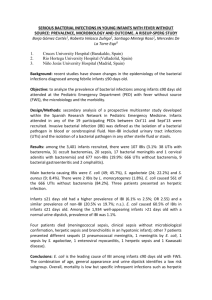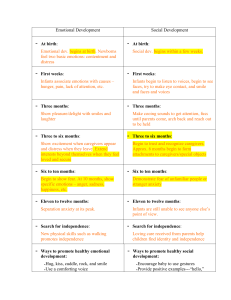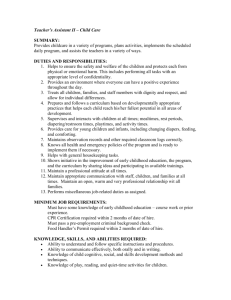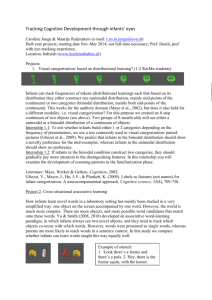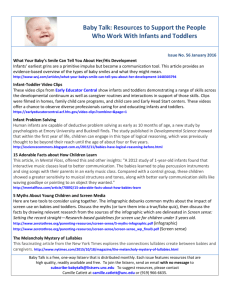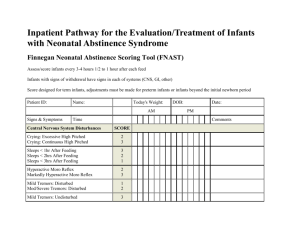Fever - Stony Brook University School of Medicine
advertisement
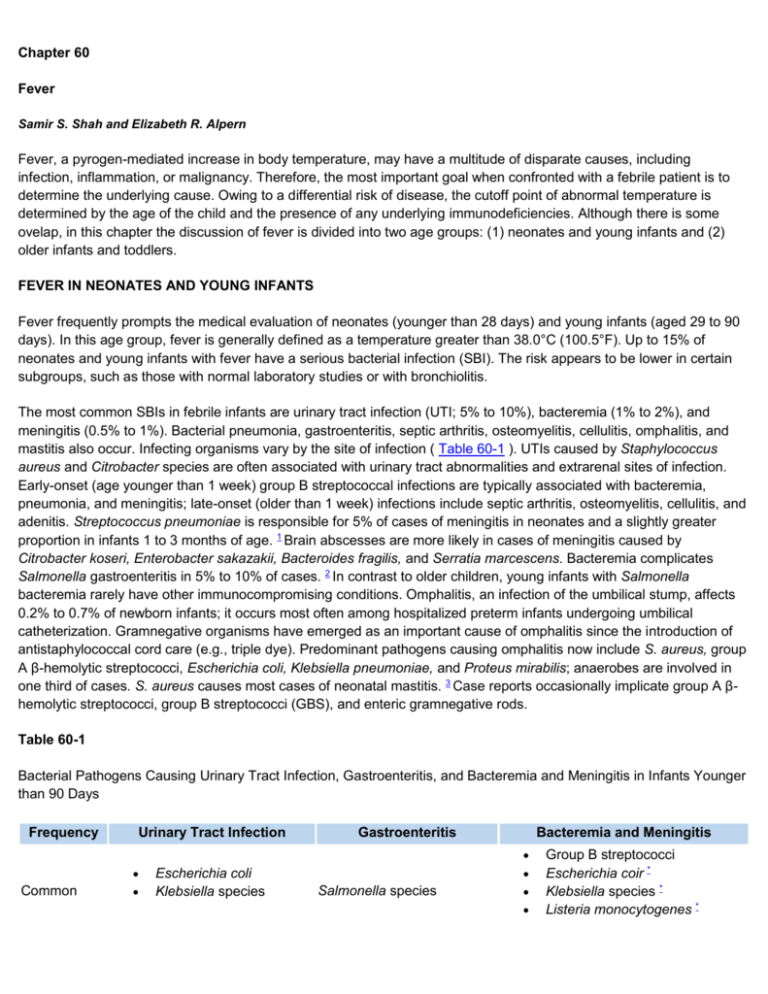
Chapter 60 Fever Samir S. Shah and Elizabeth R. Alpern Fever, a pyrogen-mediated increase in body temperature, may have a multitude of disparate causes, including infection, inflammation, or malignancy. Therefore, the most important goal when confronted with a febrile patient is to determine the underlying cause. Owing to a differential risk of disease, the cutoff point of abnormal temperature is determined by the age of the child and the presence of any underlying immunodeficiencies. Although there is some ovelap, in this chapter the discussion of fever is divided into two age groups: (1) neonates and young infants and (2) older infants and toddlers. FEVER IN NEONATES AND YOUNG INFANTS Fever frequently prompts the medical evaluation of neonates (younger than 28 days) and young infants (aged 29 to 90 days). In this age group, fever is generally defined as a temperature greater than 38.0°C (100.5°F). Up to 15% of neonates and young infants with fever have a serious bacterial infection (SBI). The risk appears to be lower in certain subgroups, such as those with normal laboratory studies or with bronchiolitis. The most common SBIs in febrile infants are urinary tract infection (UTI; 5% to 10%), bacteremia (1% to 2%), and meningitis (0.5% to 1%). Bacterial pneumonia, gastroenteritis, septic arthritis, osteomyelitis, cellulitis, omphalitis, and mastitis also occur. Infecting organisms vary by the site of infection ( Table 60-1 ). UTIs caused by Staphylococcus aureus and Citrobacter species are often associated with urinary tract abnormalities and extrarenal sites of infection. Early-onset (age younger than 1 week) group B streptococcal infections are typically associated with bacteremia, pneumonia, and meningitis; late-onset (older than 1 week) infections include septic arthritis, osteomyelitis, cellulitis, and adenitis. Streptococcus pneumoniae is responsible for 5% of cases of meningitis in neonates and a slightly greater proportion in infants 1 to 3 months of age. 1 Brain abscesses are more likely in cases of meningitis caused by Citrobacter koseri, Enterobacter sakazakii, Bacteroides fragilis, and Serratia marcescens. Bacteremia complicates Salmonella gastroenteritis in 5% to 10% of cases. 2 In contrast to older children, young infants with Salmonella bacteremia rarely have other immunocompromising conditions. Omphalitis, an infection of the umbilical stump, affects 0.2% to 0.7% of newborn infants; it occurs most often among hospitalized preterm infants undergoing umbilical catheterization. Gramnegative organisms have emerged as an important cause of omphalitis since the introduction of antistaphylococcal cord care (e.g., triple dye). Predominant pathogens causing omphalitis now include S. aureus, group A β-hemolytic streptococci, Escherichia coli, Klebsiella pneumoniae, and Proteus mirabilis; anaerobes are involved in one third of cases. S. aureus causes most cases of neonatal mastitis. 3 Case reports occasionally implicate group A βhemolytic streptococci, group B streptococci (GBS), and enteric gramnegative rods. Table 60-1 Bacterial Pathogens Causing Urinary Tract Infection, Gastroenteritis, and Bacteremia and Meningitis in Infants Younger than 90 Days Frequency Common Urinary Tract Infection Escherichia coli Klebsiella species Gastroenteritis Salmonella species Bacteremia and Meningitis Group B streptococci Escherichia coir * Klebsiella species * Listeria monocytogenes * Frequency Less common * † Urinary Tract Infection Group B streptococci Enterococcus species Pseudomonas aeruginosa Staphylococcus aureus Citrobacter species Gastroenteritis Campylobacter jejuni Yersinia enterocolitica Shigella species Bacteremia and Meningitis Streptococcus pneumoniae Neisseria meningitidis Salmonella species Group A β-hemolytie streptococci Other gram-negative bacilli † Less common in infants older than 1 month. Includes Serratia marcescens, Citrobacter species, Enterobacter species. Herpes simplex virus (HSV) infection should also be considered in acutely ill infants younger than 1 month of age. Most HSV infections (75%) in neonates are caused by HSV type 2; the remainder are caused by HSV type 1. Fetal scalp electrode use increases the risk of neonatal HSV infection. The higher infection rate after primary maternal genital HSV infection (compared with recurrent infection) may be related to the higher viral load, the longer duration of viral excretion, and the absence of transplacentally acquired protective antibodies in infants born to mothers with primary HSV infection. 4 Although the onset is typically between 11 and 17 days, 9% of infants develop symptoms within the first 24 hours of life. Most infants with skin, eye, and mouth involvement or disseminated disease present between 10 and 14 days of life. In contrast, most infants with isolated central nervous system involvement present on day 18 to 21 of life. 5 Clinical Presentation Symptoms and signs of illness vary considerably. Up to two thirds of infants younger than 2 months appear well and have a normal physical examination at the initial evaluation, despite the presence of SBI. Signs of sepsis or other systemic disease are often nonspecific and include disturbances of thermoregulation, such as fever (temperature >38°C) or hypothermia (temperature <36°C); poor feeding; and evidence of organ dysfunction. Potential cardiovascular disturbances include tachycardia (pulse >180 beats per minute), bradycardia (pulse <95 beats per minute), hypotension (systolic blood pressure <60 mm Hg in full-term infants), weak or bounding femoral pulses, mottled skin, and delayed capillary refill (>2 to 3 seconds). Respiratory abnormalities include apnea, tachypnea (respirations >60 per minute), grunting, nasal flaring, intercostal or subcostal retractions, and hypoxemia. Signs of gastrointestinal tract disturbances include a rigid or distended abdomen, absent bowel sounds, diarrhea, or bloody stools. Cutaneous findings such as jaundice, petechiae, and cyanosis may be present. Neurologic abnormalities can occur with any serious infection and include irritability, lethargy, hypotonia, and hypertonia. Signs of a specific disease process may also be detected. Infants with meningitis may have a tense or bulging fontanelle, and up to one third may develop seizures. The presence of vesicles warrants consideration of HSV infection; vesicles are detected in two thirds of children with either central nervous system or disseminated HSV infection. 5 Erythema, edema, induration, and tenderness of the breast tissue herald mastitis. Although most cases of mastitis are mild, the infection can progress rapidly. Involvement may extend beyond the breast tissue to involve the subcutaneous tissue around the shoulder and the abdomen. Periumbilical erythema, ecchymosis, edema, induration, or crepitus suggests omphalitis. Extremity abnormalities may be more noticeable to the parents. Local signs of septic arthritis or osteomyelitis include swelling, erythema, warmth, exquisite tenderness, and diminished range of motion of the affected joint or extremity. These infants often demonstrate an unwillingness to move the extremity, a finding known as pseudoparalysis. Differential Diagnosis The management of febrile infants younger than 90 days poses a challenge because of the relatively high prevalence of SBI and the inability to easily distinguish those with serious bacterial disease or HSV from those with uncomplicated, common viral illnesses caused by respiratory syncytial virus (RSV), parainfluenza viruses, influenza viruses, adenovirus, human metapneumovirus, and enteroviruses. Evaluation The diagnostic evaluation of young febrile infants is controversial. Because this group is at higher risk for SBI than are older infants and children, management traditionally involved a complete evaluation, including complete blood counts, chemistries, and cultures of urine, blood, and cerebrospinal fluid (CSF); hospitalization; and empirical antibiotic administration for all infants younger than 60 to 90 days. Because this strategy leads to the unnecessary hospitalization of many infants without SBI, several studies focused on the development of clinical screening tools to identify selected groups who are at low risk for SBI and can be safely managed in the outpatient setting. The Boston, 6 Philadelphia, 7 8 and Rochester 9 10 protocols are commonly used screening strategies ( Table 60-2 ), but they apply only to infants with stable home situations (including a telephone to receive culture results) and who do not appear ill. Table 60-2 Comparison of Protocols to Identify Febrile Infants with a Low Risk of Serious Bacterial Infection * Variable Boston † Philadelphia † Rochester Age (days) 28–89 29–56 0–60 Temperature (°C) >38.0 >38.0 >38.0 History and physical examination Normal Normal Normal Peripheral WBC count (per mm 3) <20,000 <15,000 5000–15,000 Differential count N/A Band-neutrophil ratio <0.2 Absolute band count <1500/mm 3 Urinalysis No leukocyte esterase <10WBCs/hpf No bacteria on Gram stain <10WBCs/hpf No bacteria on Gram stain CSF WBC count (per mm 3) <10 <8 N/A ‡ CSF Gram stain Negative Negative N/A ‡ Chest radiograph No discrete infiltrate § No discrete infiltrate No discrete infiltrate § Stool N/A If diarrhea: few or no WBCs If diarrhea: ≤5WBC/hpf on smear Treatment option for low-risk infants Discharge after one dose of Discharge without parenteral ceftriaxone; 24 hr followantibiotics; 24hr follow-up up Discharge without antibiotics; 24hr follow-up Risk of SBI if low risk (%) 5.4 0 1.1 Negative predictive value for SBI (%) 94.6 99–100 88–99 ¶ * Infants not meeting the low-risk criteria require hospitalization for empirical antibiotic therapy. In the Boston and Philadelphia protocols, infants younger than the age criterion should receive a complete evaluation and require hospitalization for empirical antibiotic therapy. † Infants not meeting the low-risk criteria also require lumbar puncture. § Chest radiograph is unnecessary in the absence of signs of respiratory illness such as cough, tachypnea, abnormal findings on auscultation, or hypoxia. ¶ This range of values includes extrapolation of data to account for infants excluded from the study owing to incomplete evaluation. † The Boston and Philadelphia protocols exclude febrile infants younger than 1 month of age from consideration for outpatient management. In studies that applied the Philadelphia or Boston protocol to neonates, 3% to 5% of infants younger than 1 month who were identified as low risk had SBI. 11 12 The investigators advocated that these protocols not be applied to neonates and concluded that all infants with fever in the first month of life require hospitalization for empirical antibiotic therapy. In contrast, the Rochester criteria do not take a different approach to febrile infants in the first month of life; however, this protocol has a lower sensitivity for detecting SBI than either the Boston or the Philadelphia protocol. In summary, no clear consensus exists regarding the optimal approach to febrile infants younger than 90 days. In deciding on a course of evaluation, clinicians must determine the degree of diagnostic uncertainty they are willing to tolerate when attempting to exclude SBI. Institutional or regional practice variations and personal preferences regarding test minimization and risk minimization may influence individual practice patterns. We discuss the components of evaluation included in the various protocols in the following sections. Complete Blood Count The total peripheral white blood cell (WBC) count, in combination with other laboratory parameters (see Table 60-2), can contribute to the identification of infants with SBI. Although less than half of practitioners surveyed are compliant with published guidelines for the management of febrile infants younger than 90 days, 96% of practitioners surveyed routinely obtain peripheral WBC counts. 13 Unfortunately, the complete blood count alone is an inaccurate screen for SBI in infants younger than 90 days. Using WBC cutoffs of less than 5000/mm 3 or greater than 15,000/mm 3 fails to identify at least 33% of infants with bacteremia and 40% of infants with meningitis. 14 15 Urinalysis Several rapid screening tests are available to identify UTI. The traditional urinalysis (UA) involves a combination of urine dipstick (uncentrifuged urine) detection of leukocyte esterase and nitrites plus microscopic (centrifuged urine) detection of WBCs per high-power field and bacteria per high-power field. The enhanced UA uses a combination of hemocytometry to provide a WBC count per cubic millime ter and Gram stain for bacteria on uncentrifuged urine specimens; it has a higher negative predictive value and sensitivity compared with the traditional UA. An abnormal enhanced UA (<10 WBCs/mm 3 or positive Gram stain) has a sensitivity of 94% to 96% and a specificity of 84% to 99%. 16 17 The Boston, Philadelphia, and Rochester protocols have not yet been studied using the enhanced UA; however, inclusion of the enhanced UA in these protocols would likely improve the detection of SBI in young febrile infants but might also result in more infants falsely classified as high risk. The positive predictive value of the enhanced UA (10% to 17%) is substantially lower than that of urine dipstick tests (38% to 54%). 16 Chest Radiograph Chest radiographs are no longer considered a routine part of most protocols. Several studies specifically evaluated the need for routine chest radiographs in febrile infants, but they are of limited value because they included any radiographic abnormality (e.g., peribronchial thickening) rather than the more clinically meaningful but more difficult to define finding of pneumonia. 18 19 20 A reasonable approach is to limit the use of chest radiographs to infants with abnormal respiratory signs (e.g., cough, tachypnea, hypoxia, abnormal lung auscultation). Blood Culture Several important variables affect the volume of blood necessary for culture. The magnitude of bacteremia affects blood culture yield, especially when small blood volumes are used. Although it is often difficult to obtain adequate blood samples in pediatric patients, the volume of blood in a single blood culture bottle matters more than the total number of blood cultures obtained. 21 22 A single culture containing 1 to 2 mL of blood is sufficient for the detection of most clinically important bacteremias; a 0.5-mL blood sample, though not ideal, permits the detection of some clinically important bacteremias. 23 Lumbar Puncture CSF should routinely be sent for Gram stain and culture, glucose, protein, and cell count. An additional tube is occasionally collected and held in the microbiology or chemistry laboratory in case other studies are required. Interpretation of CSF values varies by age ( Table 60-3 ). 24 25 26 27 Bacteria are evident on CSF Gram stain in up to 75% of infants with bacterial meningitis; premature infants with bacterial meningitis are less likely to have organisms detected by Gram stain. Because of the relatively low concentration of organisms, infants with Listeria monocytogenes meningitis rarely have bacteria detectable by Gram stain. Table 60-3 Guidelines for the Interpretation of Cerebrospinal Fluid Studies in Neonates and Young Infants Age Cell Count (per mm 3) Protein (mg/dL) * Glucose (mg/dL) † Preterm newborn <25 65-150 >40 Term newborn <22 20-170 >40 <4 wk <15 20-170 >40 4–8 wk <10 35–85 >40 * Data pooled from references 24-27. Infants with central nervous system infection may have cerebrospinal fluid values in the normal range; therefore, these values should be interpreted in the context of the infant's clinical status. † Cerebrospinal fluid glucose values are typically >40 mg/dL, or one half to two thirds of serum values. Detection of bacterial antigens in the CSF by latex particle agglutination (S. pneumoniae, Neisseria meningitidis, Haemophilus influenzae) or counterimmunoelectrophoresis (E. coli) has been described. Moderate sensitivity (70% to 80%), changing antibiotic susceptibility patterns, and the availability of broad-spectrum antimicrobial therapy limit the current usefulness of these tests. Polymerase chain reaction (PCR) assays for S. pneumoniae and N. meningitidis result in fewer false-negative results than do bacterial antigen detection tests, but additional research is required. Contamination of CSF with blood during a traumatic lumbar puncture confounds the accurate interpretation of results. If the ratio of WBCs to red blood cells (RBCs) in the peripheral blood remains constant when peripheral blood is introduced into the subarachnoid space during lumbar puncture, comparing the ratio of observed to predicted CSF WBCs may raise or lower the suspicion for bacterial meningitis. A predicted CSF WBC count can be calculated using the following formula: Predicted CSF WBCs = CSF RBCs × ( Blood WBCs / Blood RBCs ) A retrospective study determined that an observed-predicted CSF WBC ratio less than 0.01 had a sensitivity of 100% (95% confidence interval, 74% to 100%) in predicting the absence of bacterial meningitis. 28 Some experts dispute the assumption of a fixed ratio of WBCs in the CSF and peripheral blood. In the Boston and Philadelphia screening protocols, infants with difficult to interpret (e.g., grossly bloody) lumbar punctures are not considered low risk; these infants are hospitalized and receive empirical antibiotic therapy. In certain situations, a repeat lumbar puncture 12 to 24 hours later may clarify the ambiguity of the initial results. Additional Studies When HSV is a concern, CSF should be sent for PCR testing. This technique has a sensitivity and specificity of 96% and 99%, respectively. 29 In infants with skin, eye, or mucous membrane HSV disease, and in many with either central nervous system or disseminated disease, HSV can often be isolated from conjunctival, throat, and rectal swabs by culture or PCR. HSV from these cutaneous sites can usually be detected by culture within 48 hours. Although a negative culture result cannot completely exclude HSV infection, most infants with HSV infection have positive culture results from cutaneous sites. 5 False-negative PCR results are rare but may occur when CSF specimens are obtained very early in the course of HSV illness. In such cases, repeat testing 2 to 3 days later confirms the diagnosis. PCR testing of CSF remains reliable for up to 7 days after the initiation of acyclovir; 50% of specimens remain PCR-positive 8 to 14 days after the initiation of acyclovir. 30 Infants with disseminated HSV may also have laboratory evidence of hepatitis, coagulopathy, and thrombocytopenia. Other Considerations The prevalence of SBI may be lower among some febrile infants with a bronchiolitis syndrome. In a prospective, multicenter study, RSV-positive infants younger than 60 days were less likely to have an SBI than were RSV-negative infants (7% versus 12.5%). 31 However, the subanalysis found some differences by age. Infants 28 days or younger had an overall SBI rate of 13.3%, regardless of RSV status. In contrast, RSV-positive infants 29 to 60 days of age had a lower risk of SBI than did RSV-negative infants (5.5% versus 11.7%; relative risk, 0.5). The SBIs in RSV-positive infants aged 29 to 60 days were due solely to UTI; no RSV-positive patient in this age group had bacteremia or meningitis. In summary, among infants 28 days and younger, the risk of SBI is substantial and is not altered by the presence of RSV. In these children, we continue to perform a complete evaluation, including urine, blood, and CSF studies. RSVpositive infants 29 to 60 days of age have a clinically important rate of UTI, and because we cannot exclude SBI in any febrile infant in this age group without a complete evaluation, blood and urine cultures are routinely performed in hospitalized infants. In well-appearing infants, the lumbar puncture is occasionally deferred unless changes in the patient's condition warrant additional evaluation. In infants 29 to 60 days of age who will be discharged home from the emergency department, a complete evaluation, including lumbar puncture, may be appropriate. In determining the extent of laboratory evaluation, clinicians should consider these data in combination with other factors, including the family's reliability to assess the infant's clinical deterioration, access to a telephone, proximity to medical care, and likelihood of follow-up evaluation within 24 hours after emergency department discharge or availability of 24-hour physician support for hospitalized patients. Office-Based Strategies The protocols summarized in Table 60-2 were developed for use in the emergency department setting. A large proportion of office-based physicians do not routinely follow any of these strategies. 32 In an office-based study of 3066 febrile infants younger than 3 months, the overall rate of SBI was similar to the rates found in studies conducted in the emergency department: UTI (5.4%), bacteremia (2.4%), and meningitis (0.5%). 33 Most cases of bacteremia or meningitis occurred during the first month of life, when 4.1% of infants were affected; in contrast, 1.9% and 0.7% of cases occurred during the second and third months of life, respectively. Practitioners in this study followed current guidelines in 42% of cases; however, they correctly treated 61 of 63 cases of bacteremia or bacterial meningitis with empirical antibiotics during the initial visit. These findings suggest that if close follow-up care is attainable in an officebased setting (most infants in the study had more than one office visit and multiple telephone contacts), the management of selected cases by an experienced clinician may be more important than strict adherence to published recommendations. This strategy can reduce costs and complications associated with routine evaluation and hospitalization. This study, however, illustrated limitations that warrant consideration. Two infants with life-threatening infections did not receive antibiotics initially; both these infants would have been treated initially if they had been evaluated by at least one of the commonly used screening protocols. Given the relatively high prevalence of UTI and the wide availability of screening UA tests, practitioners should strongly consider routine UA in all young febrile infants. Admission Criteria In each of the protocols outlined (see Table 60-2), all infants not meeting low-risk criteria require hospitalization and empirical antibiotic therapy. Any ill-appearing infant, regardless of laboratory test results, also requires hospitalization and empirical antibiotic therapy. Treatment Infants hospitalized for suspected SBI should receive broad-spectrum antimicrobial therapy. During the first month of life, either ampicillin plus an aminoglycoside (e.g., gentamicin) or ampicillin plus a third-generation cephalosporin (e.g., cefotaxime) is recommended. Between 30 and 90 days of life, cefotaxime alone is usually sufficient. A systematic review determined that the prevalence of infections caused by either L. monocytogenes or enterococci (organisms for which cephalosporins are not effective) was 0.7% among febrile infants younger than 30 days but only 0.2% among infants 31 to 60 days of age. In this review, no case of Listeria infection was seen in infants older than 1 month. 34 The combination of vancomycin and cefotaxime should be considered for infants with CSF parameters suggestive of bacterial meningitis or those with gram-positive cocci identified on CSF Gram stain until cultures have excluded drugresistant S. pneumoniae. Infants with gram-negative meningitis should receive an empirical aminoglycoside plus either ceftazidime or imipenem. Duration of therapy is discussed in detail in Chapter 63 on central nervous system infections, Chapter 69 on UTIs, and Chapter 67 on lower respiratory tract infections. In general, infants with bacteremia or UTI should receive at least 2 weeks of therapy. Meningitis should be treated for approximately 2 weeks after bacteriologic cure. For meningitis caused by GBS, L. monocytogenes, or S. pneumoniae, 2 weeks of total therapy is usually sufficient. Delayed sterilization is common for infants with gram-negative meningitis; therefore, they should receive a minimum of 3 weeks of therapy. Infants with complicated disease (e.g., brain abscess) may require a longer duration of therapy. Repeat lumbar puncture after 48 to 72 hours of therapy is routinely recommended for meningitis due to drug-resistant S. pneumoniae or gram-negative organisms. Infants with suspected HSV infection should receive high-dose acyclovir (60 mg/kg per day). 35 Infants with skin, eye, or mucous membrane disease receive 14 days of intravenous therapy. Infants with disseminated or central nervous system disease require at least 21 days of therapy. Many experts suggest repeating the lumbar puncture upon completion of the 21-day acyclovir course and extending the duration of acyclovir therapy if the CSF PCR remains positive for HSV. In such situations, consultation with a pediatric infectious disease specialist is recommended. Discharge Criteria Emergency Department Discharge The Boston protocol includes administering ceftriaxone to all low-risk infants before discharge. Infants subsequently identified to have positive culture results return for continuation of parenteral antibiotic therapy. The Philadelphia protocol requires hospitalization and empirical antibiotic therapy for all febrile infants younger than 28 days of age, but it allows low-risk febrile infants 29 to 56 days of age to be managed in the outpatient setting without antibiotics. Approximately 40% of presenting febrile infants are classified as low risk by the Philadelphia protocol. The Rochester protocol permits discharge of approximately 45% of febrile infants younger than 60 days without antibiotics; however, 1% to 12% of these infants may have an SBI. Hospital Discharge Historically, infants were discharged if the concern for SBI no longer existed, the infant was clinically stable, and culture results had been negative for at least 48 hours. Earlier hospital discharge may be possible for some infants, because most pathogens grow from culture within 24 hours. A pathogen was detected in culture after 24 hours in 1.1% of 3166 febrile 28- to 90-day-old infants; however, all 8 infants with meningitis had growth from CSF cultures less than 24 hours after specimen collection. 36 Additional data on time to pathogen detection are presented later in this chapter. The patient's diagnosis (e.g., UTI, bacteremia, meningitis) and clinical response ultimately determine the duration of hospitalization. Prevention Group B Streptococcal Infection Maternal intrapartum chemoprophylaxis with at least two doses of penicillin or ampicillin reduces the vertical transmission of GBS from colonized mothers to their neonates. Women allergic to penicillin can receive clindamycin, erythromycin, or, in the absence of immediate-type hypersensitivity, a first-generation cephalosporin. Approximately 20% of pregnant women require intrapartum chemoprophylaxis, based on current protocols. These strategies have dramatically decreased the incidence of early-onset group B streptococcal disease. However, because intrapartum penicillin administration does not reliably eradicate GBS from the colonized infant, its impact on late-onset disease is less significant. Some studies raised the concern that intrapartum ampicillin use led to an increase in neonatal infections with ampicillin-resistant pathogens 37 38 and gram-negative bacteremia. 39 Recurrent group B streptococcal disease occasionally occurs. Most GBS isolates in recurrent infections are genotypically identical to isolates from the initial infection. The likely mechanism involves recurrent infection due to persistent colonization with the original strain. In patients with recurrent infection, the penicillin susceptibility of the isolate should be determined by minimum inhibitory concentration (MIC) testing. Additional evaluation of the infant may include testing for human immunodeficiency virus (HIV) and analysis of B-lymphocyte function. Consultation with pediatric infectious disease or immunology specialists is warranted. Oral rifampin therapy (20 mg/kg per day during the last 4 days of parenteral therapy) may be used in an attempt to eradicate mucosal GBS colonization. This regimen successfully eradicates mucosal colonization in 50% of cases. 40 41 Herpes Simplex Virus Infection Cesarean section within 4 hours of membrane rupture in a mother with active genital herpes at the time of delivery can prevent many neonatal HSV infections. However, three fourths of mothers of infants with neonatal HSV infection are asymptomatic or have unrecognized infection, and neonatal infection can occur in an infant delivered by cesarean section in the presence of intact membranes. Symptomatic infants and those with findings that suggest a high likelihood of HSV infection (e.g., vesicles) should receive intravenous acyclovir while awaiting study results. For asymptomatic infants born to mothers with active genital HSV lesions, HSV cultures should be obtained at 24 to 48 hours of life from the conjunctiva, mouth, or nasopharynx and from the rectum or stool. Asymptomatic infants do not require any antiviral therapy while awaiting HSV culture results, although many experts suggest empirical acyclovir in those delivered vaginally. In a Nutshell Up to 15% of febrile infants younger than 90 days have an SBI. Screening protocols can identify infants younger than 90 days who are at low risk for SBI. These infants may be candidates for outpatient management. RSV-infected infants aged 29 days and older have a lower risk of bacteremia and meningitis than do infants who are not infected with RSV; however, the risk of UTI in this population remains significant. In contrast, infants 28 days and younger have a high risk of SBI regardless of their RSV status. Intrapartum prophylaxis for GBS dramatically decreases the rate of early-onset group B streptococcal disease in neonates but is less effective in the prevention of late-onset disease. On the Horizon PCR-based tests to rapidly identify bacterial causes of meningitis and bloodstream infection. Further clarification of the role of viral pathogen testing on the management of young febrile infants. Inclusion of enhanced UA in the protocols that identify young infants at low risk for SBI. FEVER IN OLDER INFANTS AND TODDLERS Although there is some overlap with the previously discussed age group, fever in older infants and toddlers (2 to 24 months) is generally defined as body temperature greater than 38.5°C (101.3°F). These young children have waning maternal antibodies and increasing exposure to contagious illnesses and may experience multiple febrile illnesses each year. Differentiating serious illness from benign viral syndromes is the most important aspect of care of these febrile children. Several clinical entities are of particular importance in this population. Healthy, well-appearing young children with fever but without an identifiable focal bacterial infection may have an occult infection, including bacteremia, UTI, and pneumonia. Occult UTI and pneumonia are discussed in detail in Chapters 69 and 67, respectively. Occult bacteremia is discussed in the following sections. Clinical Presentation Occult bacteremia is defined as the presence of bacteria in the blood of a well-appearing febrile child (temperature >39°C [102.2°F]) between the ages of 2 and 24 (or 36) months. 42 By definition, these children have an intact immune system and lack an identifiable focal bacterial infection (e.g., abscess, cellulitis, pneumonia) or pathognomonic viral entity (e.g., herpes stomatitis, varicella). Historically, occult bacteremia has overwhelmingly been due to S. pneumoniae and H. influenzae type B (HIB). 43 44 45 Other causative organisms include Salmonella species, nontypeable H. influenzae, group A β-hemolytic streptococci, Enterococcus species, and N. meningitidis. Recently, the overall risk of occult bacteremia among febrile infants and toddlers has been significantly reduced by administration of the HIB and heptavalent pneumococcal conjugate (PCV7) vaccines. 1 46 47 48 49 50 51 Before the licensure of the HIB vaccine in 1987, the prevalence of occult bacteremia among febrile young children was between 3% and 11%. 43 44 45 52 53 However, after widespread use of the HIB vaccine, the reported overall rate of occult bacteremia in immunized children is less than 2%. 54 55 With the release of PCV7 in 2000, there has been nearly a 70% decrease in the rate of invasive pneumoccocal disease 56 ; in addition, the overall prevalence of occult bacteremia declined to less than 1%. 57 The risk of occult bacteremia is determined by the age of the child, his or her immunization status, and clinical parameters such as height of fever. Occult bacteremia is a concern because of its possible progression to deep-seated focal infection, such as osteomyelitis or meningitis, or to sepsis syndrome. The risk of invasive disease due to occult bacteremia depends on the infecting organism. When HIB was a prominent causative organism, the risk of invasive disease with known occult HIB bacteremia was between 25% and 44%. 45 58 However, occult pneumococcal bacteremia is associated with a significantly smaller risk (0.6%) of invasive disease. 45 Because HIB is no longer a major concern in immunized populations, the risk of progression to meningitis or death is substantially reduced. Currently, the overall risk of meningitis or death in children with occult bacteremia is approximately 1.8%. 54 Differential Diagnosis The differential diagnosis of fever in a young child is extremely broad. It is important to differentiate children at risk for occult bacteremia from those at risk for nonoccult bacteremia. Children with identifiable signs and symptoms of invasive disease, those with focal bacterial infections, and those ill enough to warrant lumbar puncture and hospital admission are certainly at risk for bacteremia, but they fail to meet the definition of children at risk for occult bacteremia. Viral syndromes, otitis media, bronchiolitis, and unidentified pneumonia or UTI are common entities that have presentations similar to that of occult bacteremia. Some of these entities may be complicated by the presence of occult bacteremia, and some may even predispose patients to develop bacteremia, further complicating the evaluation and management of these febrile children. Diagnosis The diagnosis of occult bacteremia is dependent on a complete history and physical examination. Immunization status is an important component of the history to determine the risk of occult bacteremia by specific organisms; those who have not been immunized for HIB or S. pneumoniae are at increased risk. The risk of occult bacteremia also increases with increasing body temperature. The risk in children with fevers higher than 40°C is approximately twice the risk in those with fevers lower than 40°C. 59 However, many children with occult bacteremia do not have fevers greater than 40°C, and the vast majority of children with fevers that high do not have occult bacteremia. The response to antipyretics does not reflect the risk for occult bacteremia. Children with identifiable otitis media have the same overall risk for occult bacteremia as do those without this discernible infection. 54 58 Children presenting with simple (also known as “typical”) febrile seizures and no evidence of focal infection also have a similar prevalence of occult bacteremia. 60 61 In contrast, children in this age group diagnosed clinically with bronchiolitis, croup, or stomatitis have a decreased risk for occult bacteremia associated with the febrile illness. 31 62 63 Many screening laboratory studies have been evaluated as markers for occult bacteremia. However, because of the low overall prevalence of occult bacteremia in the population, these studies are limited in their positive predictive value. The complete blood count is the most widely studied diagnostic test. 43 53 55 57 59 64 In one study, a WBC count greater than 15,000/mm 3 was associated with a positive predictive value of 5% 55 ; another study found that an absolute neutrophil count greater than 10,000/mm 3 yielded a positive predictive value of 8%. 59 Therefore, although the risk of occult bacteremia increases with an increasing WBC count or absolute neutrophil count, the vast majority of patients with a leukocytosis or increased neutrophil count do not have occult bacteremia. C-reactive protein (CRP) has been studied as a marker for SBI and occult bacteremia. 65 66 Although the risk of SBI increases with an increasing CRP level, its utility in detecting occult bacteremia is modest. 65 Using a CRP value of 4.4 mg/dL or greater, the positive predictive value is only 30% (i.e., only 30% of patients with a CRP level ≥4.4 mg/dL have occult bacteremia). However, the negative predictive value is 94% (i.e., 94% of patients with a CRP level <4.4 mg/dL do not have occult bacteremia). 66 Blood culture remains the gold standard for diagnosing occult bacteremia. The most important limitation of a blood culture is the delay in identifying positive cultures. If a continuously monitored carbon dioxide production pediatric system is used, 94% of pathogenic cultures will be identified as positive within 18 hours. 54 The prevalence of occult bacteremia has decreased, and the prevalence of contaminated cultures now approximates the prevalence of true pathogens. Treatment The evaluation and treatment of patients at risk for occult bacteremia are controversial. Owing to the difficulty of diagnosing occult bacteremia without waiting for test results, expectant antibiotic use has been advocated by some to decrease the risk of adverse outcomes such as meningitis or sepsis. In the pre-HIB vaccine era, amoxicillin, amoxicillin–clavulanic acid, and ceftriaxone were studied as expectant treatment and were determined to have no statistically significant effect on serious adverse outcomes. 44 53 In another study, ceftriaxone was noted to decrease the risk of “definite” focal infections but was not effective in decreasing the risk of acquiring a “definite or probable” focal infection. 45 In this study, H. influenzae and Salmonella species were the only causes of subsequent meningitis in patients with occult bacteremia. 45 67 Because occult bacteremia has changed owing to the availability of immunizations and the changing epidemiology of causative organisms, many advocate treating only patients with documented bacteremia, rather than treating all patients at higher risk. This has been supported in several meta-analyses and comparison studies. 68 69 70 If gram-positive cocci are identified, empiric therapy for S. pneumoniae, the most likely pathogen, with amoxicillin, ampicillin, or ceftriaxone is reasonable. The well-appearing patient in whom fever has resolved may be managed in the outpatient setting. If the patient appears ill, empiric coverage should be broadened to provide coverage against methicillin-resistant S. aureus with vancomycin. If gram-negative rods are identified, Salmonella and H. influenzae are most likely. The patient requires hospitalization and empiric therapy may include a third-generation cephalosporin with or without an aminoglycoside. Ill-appearing patients should receive either a carbapenem or a beta-lactam/betalactamase inhibitor combination. Admission Criteria If a child evaluated for occult bacteremia has a positive blood culture within 18 to 24 hours, there is a high probability that the positive culture indicates a true pathogen. Currently, S. pneumoniae causes most episodes of occult bacteremia and has a very high spontaneous resolution rate. However, the bacteremia still creates a risk of hematogenously seeded infection. A patient with a positive blood culture result but resolution of fever and lack of signs or symptoms of focal infection upon reevaluation can be safely assessed with a repeat blood culture and followed as an outpatient. 71 However, persistently febrile or ill-appearing patients with positive blood cultures require a full evaluation to assess for new focal infections, including meningitis. If no antibiotics have been prescribed previously, the physical examination may reliably indicate the presence or absence of focal infection. Complete blood count, blood culture, UA and urine culture, chest radiograph, and lumbar puncture should be considered in an ill-appearing febrile child with bacteremia. Hospital admission and treatment with a broad-spectrum antibiotic, such as ceftriaxone, are indicated. Vancomycin is added in cases of suspected meningitis. Discharge Criteria When children with positive initial blood cultures warrant admission (i.e., their clinical appearance or laboratory studies are not reassuring), the repeat culture is followed closely for the first 24 hours. Several studies using continuously monitored carbon dioxide blood culture systems have documented that the great majority of pathogens from immunocompetent hosts are detected within 24 hours. 54 72 73 Therefore, well-appearing immunocompetent patients may be safely discharged home if their repeat blood cultures remain negative for at least 24 hours. Total length of treatment is determined by the presence or absence of any particular focal infection that may have developed and should be tailored to the identified infection. Prevention The HIB and conjugate pneumococcal vaccines are the most effective means of preventing occult bacteremia. The conjugate pneumococcal vaccine is immunogenic for 7 of the 90 S. pneumoniae serotypes. Although early data are promising, there is theoretical concern about serotype shift due to nonvaccine organisms. In a Nutshell Occult bacteremia is the presence of pathogenic bacteria in the blood of a well-appearing febrile child aged 2 to 24 (or 36) months who lacks a focal bacterial infection. Occult bacteremia has the potential to progress to focal infection (including meningitis) or sepsis. The overall prevalence of occult bacteremia in at-risk children is less than 2%. Widespread HIB vaccination had dramatically decreased the prevalence of occult bacteremia, and use of the heptavalent pneumococcal conjugate vaccine may lead to an even further decrease. S. pneumoniae is the most common causative organism and has a very high spontaneous resolution rate. The overall risk of meningitis or death in children with occult bacteremia is approximately 1.8%. Expectant antibiotic treatment of patients with possible occult bacteremia has not been shown to definitively prevent subsequent focal or systemic infection. Patients with positive blood culture results should be carefully evaluated for focal infections and admitted to the hospital if they appear ill or are persistently febrile. On the Horizon Procalcitonin and urine antigen assays are being evaluated as improved rapid diagnostic studies to evaluate patients at risk for occult bacteremia. 74 75 Further study of the changes in the epidemiology of occult bacteremia due to the pneumococcal vaccine is warranted, with particular attention to decreased prevalence, possible seroreplacement, and crossimmunogenicity between vaccine serotypes and closely related nonvaccine serotypes.

